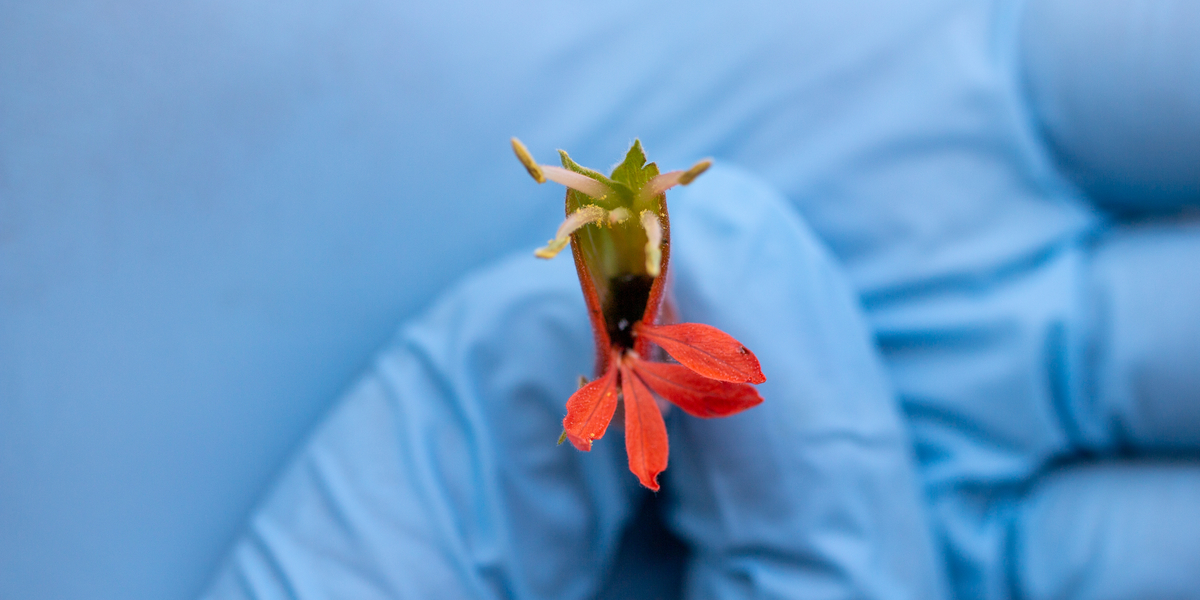
Nectar: the prized drink of choice for visiting pollinators. A single drop offers an array of nutrients, with sugars and amino acids often topping the charts. Some nectars, however, have compositions more colorful than others. These unique cases often draw the attention of curious scientists. Unfortunately for Plant and Microbial Biology grad student Evin Magner, handling–and taste testing–the strikingly black nectar of Melianthus minor flowers came with some unfortunate side effects.
"I started having breathing troubles. My heart is racing, I'm not feeling great. My wife notices that I'm starting to get a rash. And so I ended up going to the emergency room,” says Magner. “And they take me back and find out that I am in anaphylactic shock.”
Magner had developed an extreme aversion to ellagic acid, a chemical with a huge role in Melianthus nectar's inky appearance. But his reactions didn’t stop his research. By the end of his study, he could chemically replicate how Melianthus minor nectar acquires its dark color–from its flower’s genesis to its end.

A potent pigment
Melianthus flowers first produce clear, greyish nectar. But by the time the flower matures, the nectar has completely darkened. "It’s actually darker and more ‘black’ than the black standards we use today. For example, color cards that are used in photography…those blacks.”
The aesthetic aspect of colored nectars appealed to Magner. But it was his lab’s connection to Rachel L. Vannette of the University of California-Davis that opened a door for Magner to study Melianthus minor. A few years prior, Rahul Roy, a former postdoc of the Carter lab, connected with Vannette over the unique black nectar of the Melianthus minor flowers she had access to in their campus collection.
“One of the first drawings ever done of a Melianthus minor plant was actually in a Curtis’s Botanical magazine,” says Magner. “All of the prints were hand painted in the 1780s, and they used the black nectar for the black nectar in the illustration. It blew me away. The rest of the drawing was done with black ink, but it had nowhere near the same intensity.”

The combination of art and science piqued Evin’s interest, launching a trip to California with funding from the Bell Museum to discover what made Melianthus nectar so incredibly dark.
He initially used a mass spectrometer to evaluate the chemical makeup of his nectar samples. Through his work, he found three chemical clues as to how the nectar makes its pigment: gallic acid, ellagic acid, and iron. Interestingly, all three of these are components of iron-gall ink, the most commonly used ink in medieval times.
"We knew iron-gall ink to be from Oak galls. They used the gallic acid in there to react with iron salts, and that produces the black ink that we see today.”
Gallic acid and iron salts on their own produce only a brownish, light black pigment, however. So to darken the ink, some ancient ink-producers added pomegranate peels. “While they didn't understand what that was doing, pomegranate peels are high in ellagic acid. It was ellagic acid that was really darkening it.”

After experimenting with different combinations of each component, Evin had his breakthrough. At first, the nectar’s clearish, brownish color can be attributed to the combination of gallic acid and ferric ion (Fe3). But as the flower matures, it converts the gallic acid into ellagic acid, which is what really gives the iron rich nectar its startlingly dark pigmentation.
“We were able to just start with just the nectar proteins, and subsequently add the gallic acid, the sugar, the iron, and in those orders, and at the same pH, we get that same beautiful coloration.”
Bird’s the word
With this information in hand, Magner collaborated with CBS alumni Amod Zambre to further understand what role the color of Melianthus minor plays in attracting pollinators. They found the nectar particularly visible to birds, unsurprising given that birds are Melianthus minor’s primary pollinators. In a birds-eye view, the pigmented nectar highly contrasts with the petal colors, a perfect “pathway” to the flower’s nectaries.

“What's really interesting is that on the sides of the flowers, the tissue actually thins out to such a degree that you can actually see that black coloration through that tissue,” says Magner. “So it's almost like a window.”
Melianthus minor’s closest relative has clear nectar and attracts insect pollinators. Magner is no further in teasing apart the “why” and “how” of these differences, but he suggests that nectar composition– including nectar color–could deepen an understanding of the intertwined evolutionary history and relationship between plants and their pollinators. And colored nectars in general could have some unique applications.
“There's potential for its use in solar technologies, because the darker things are, the more they can absorb heat. And then there's the more cultural side of things in that this is a new and exciting pigment that can be used,” says Magner. “I just think that's kind of fascinating, and I think in and of itself has its own cultural importance.”
— Adara Taylor